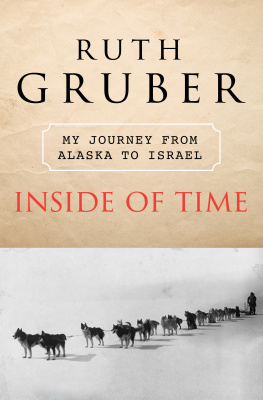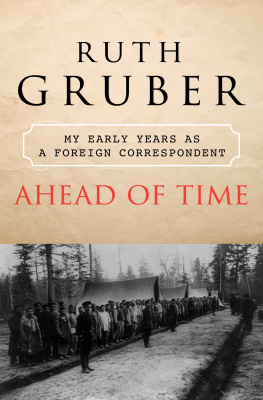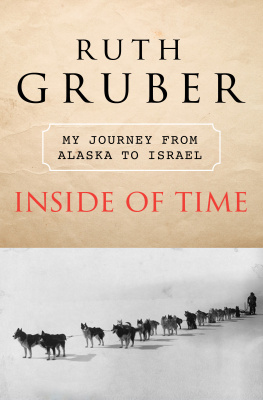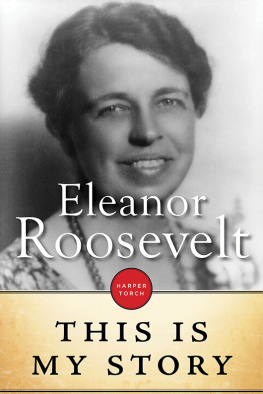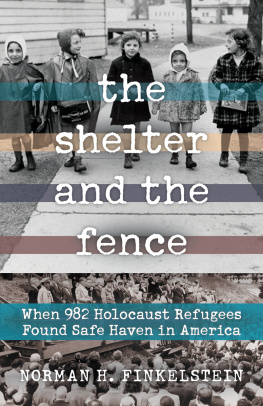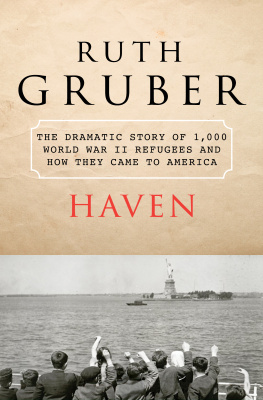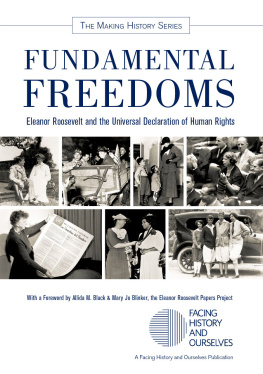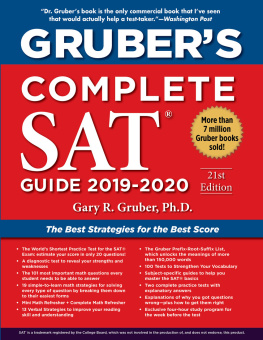Inside of Time
My Journey from Alaska to Israel
Ruth Gruber

To my young grandchildren
Michael and Lucy Evans
Joel and Lila Michaels
CONTENTS
ELEANOR VISITS THE HOLY LAND
It was on my first trip to Alaska during World War II that I learned to live inside of time. I might be sitting in a place like Nome. I would send a radio message to Anchorage for a bush pilot to pick me up and fly me to Point Barrow.
The answer would come back, See you TuesdayWEAPERS. WEAPERS meant weather permitting. Tuesday came. The next Tuesday came. Then the next. But no bush pilot. Usually it was the weather. Or the pilot was sick or on a binge.
Until that fateful voyage, I had been a restless fighter against time. If the elevated train from my shtetl in Williamsburg, Brooklyn to Manhattan was a few minutes late, I screamed at it under my breath like a longshoreman.
Now, instead of sending my blood pressure rocketing, I began to utilize the days and weeks of waiting. Wherever my lap was became my desk. I could fill more pages in my notebooks, send more reports to Harold L. Ickes, secretary of the interiorfor whom I was working as field representative and later as special assistantand interview more people, especially the Eskimos, whose serenity and affirmation of life I so admired.
Time was no longer my enemy. Now it enveloped me, liberated me. Living in a magical circle of space and energy helped fuel my love for words and images, the tools with which I would later fight injustice.
The patience and perseverance I learned stood me in good stead when Ickes, making me a simulated general, sent me to war-torn Europe in 1944 to shepherd one thousand refugees to safe haven in Oswego, New York. When we were blacked out, our engines silenced while Nazi planes flew over us and U-boats hunted us down, some of the wounded soldiers we carried shouted to me, Its these damn Jewswe survived all the battles, from Casablanca to Anzio, and were going to die because the Nazis know what were carrying.
To show the soldiers what we were carrying, I arranged to have our gifted singers and actors perform for them. When the soldiers, their heads bandaged and their arms or legs in casts, watched and listened to some of our beautiful young women, they began to applaud with delight. It seemed to me they were seeing these artists not as objects of derision but as human beings.
Some talked to me of how amazed they were by the vitality and determination to survive of people who had suffered the greatest evil the world had known. The captains early order to me, We dont want any fraternization on this ship, blew into the sea. The soldiers kept coming to our part of the ship bringing chocolate and cookies for our children and spending hours learning the life stories of some of the refugees. Anti-Semitism and hostility evaporated.
When the war ended, I traveled as a foreign correspondent through Europe and the Middle East with the Anglo-American Committee on Palestine. In Germany, we visited the terrible Displaced Persons camps taking testimony from the refugees. Some of the DP camps were former death camps and army camps in which these survivors of the Holocaust were now sleeping on the same wooden shelves where thousands had died during the war. I wanted to shake the world by its lapels: Get rid of these camps. Open the doors of Palestine! After what theyve suffered, let these Holocaust survivors go home.
A year later, Helen Rogers Reid, the vice president of the New York Herald Tribune, sent me to cover UNSCOPthe United Nations Special Committee on Palestine. It was only the twentieth committee studying the problems of Palestine and the Arab-Jewish conflict.
We were listening to eloquent Jewish and Arab leaders in the YMCA in Jerusalem when I learned that a small American excursion boat named Exodus 1947, holding forty-five hundred Holocaust survivors, was being attacked by British destroyers and Ajax, the famous British cruiser. I rushed to Haifa and stood at the dock watching the battered ship enter the harbor. Three were dead: Bill Bernstein, the American second mate who had been bludgeoned to death, and two sixteen-year-old orphans.
The British officers made no effort to stop me from shooting pictures of soldiers dragging people off the ship and forcing them onto three ships sitting in the harbor. The commanding officer told me they were bound for Cyprus.
I flew to Cyprus to wait for them. It was a hellhole of sand and wind. No plumbing. No water. No privacy. I tried to capture it all in the articles and photos I kept sending the paper.
Cyprus became Helen Reids passion. Determined to use her influence with the British to get the Jews out of Cyprus, she used my articles as her weapon, but she failed. The British kept the Jews imprisoned on their island even after Israel was born.
David Ben-Gurion, the architect of the new nation, moved to Kibbutz Sde Boker in the Negev in the last years of his life. If we do not conquer the desert, he told me, the desert will conquer us. After his wife, Paula, died, he returned to his modest home in Tel Aviv, where I visited him shortly before his death in 1973. One of the soldiers stationed at the entrance told me, Its good youve comeso few people come to see him now.
He was lying on the upper floor on a narrow bed, covered with a white quilt. On the floor below him were his sole companions, soldiers who guarded him, cooked for him, and occasionally ventured upstairs to make sure he was all right.
Pull up a chair, he spoke in a soft voice. I took a tape recorder out of my bag. He noticed it immediately.
Put that thing away, he demanded.
B. G., I protested, I want to have a record of your voice.
You dont need a recordits in your head.
I slipped the tape recorder back in my bag and took out a fresh notebook. A little smile played on his lips. It was the fall of 1973. I had come to write a book on the Yom Kippur War called Israel on the Seventh Day. A sadness swept over me realizing that the air in the room talked of death. I knew how badly the country would miss him.
Master, I asked, will there ever be peace between the Arabs and the Jews?
Yes.
When?
Not in my time, he sat up in his bed. But in yours and your childrens.
Where will it come from? I pressed.
Egypt, he said.
Egypt? I was incredulous. Thats where the fedayeen (terrorists) come from. Egypt starts every war. Theyre the ones who throw the grenades into childrens homes. How can peace come from Egypt?
He waved his hand as if brushing the thought away.
Forget that, he told me. There is a whole generation of young people rising up who know we can cooperate. They still have diseases we cured fifty years ago. Our doctors and our scientists can help cure them. They have natural resources and raw materials that we need. Yes, there will be peace.
I took his hand, knowing it was the last time I would see him. He died on December 1,1973.
Readers who may wonder at my recollections of whole scenes and dialogue may feel reassured to know that they come from the 350 notebooks I filled with descriptions and interviews recorded right on the spot in my own idiosyncratic version of short longhand.
They also come from my reports to Secretary of the Interior Harold L. Ickes, which began in Alaska in 1941 for eighteen months, and then continued through my years in Washington as his special assistant until January 1946.
Returning to journalism as a foreign correspondent in early 1946, my articles and photos have given me the eyewitness material I use here in covering the postwar years through the birth of Israel, and on to 1952, when

